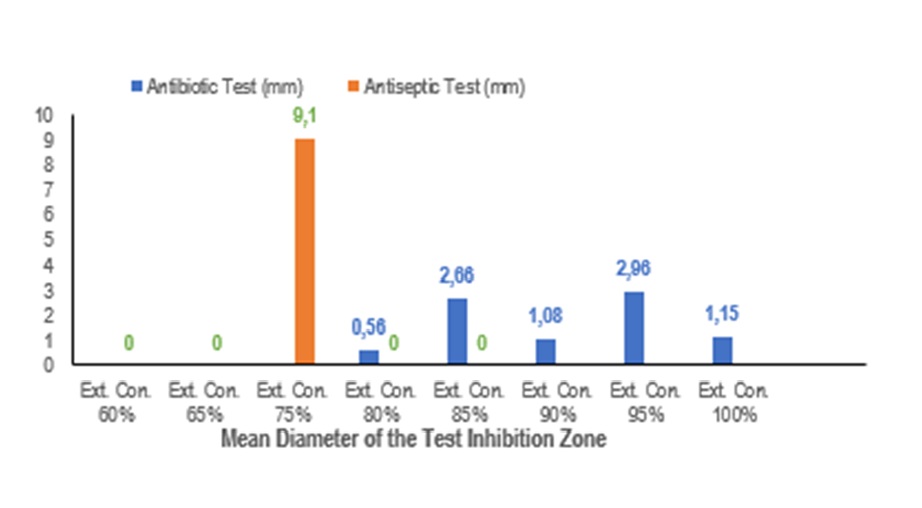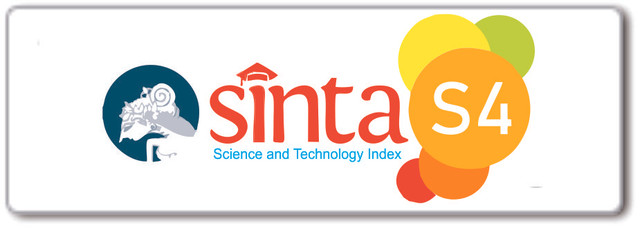Utilization of Roots of Muli Banana Plants (Musa acuminata Linn.) as Antibiotics and Antiseptics
Abstract
Diseases caused by bacteria can usually be combated by administering antibiotics and using antiseptics. However, there are some groups of pathogens, such Escherichia coli as well as Staphylococcus aureus, which are highly resistant to the antibiotics amoxicillin, penicillin, tetracycline and chloramphenicol. One of the efforts to control these bacteria is by using bioactive compounds derived from plants. Banana plants contain secondary metabolite compounds flavonoids, saponins, and tannins that can act as anti-infective agents, including muli banana (Musa acuminata Linn.). Banana plant roots as natural ingredients can be an alternative to antiseptics because they contain antibacterial compounds with milder side effects than long-term use of alcohol-based antiseptics that can reduce skin moisture. This study was conducted to determine the efficacy of banana muli root extract (M. acuminata Linn.) as an antibiotic and antiseptic. The hypothesis in this study is that the root extract at a certain concentration is thought to have effectiveness as an antibiotic (E. coli) and antiseptic (S. aureus). In this study, the Kirby-Bauer method was applied by agar diffusion and the results of the inhibition zone test were formed around the paper disc. The results showed that the optimum efficacy of muli banana root extract (M. acuminata Linn.) as an antibiotic (E. coli ATCC 25922) was at a concentration of 95% (2.96 mm) and as an antiseptic (S. aureus ATCC 25923) at a concentration of 75% (9.1 mm).
Downloads
References
Advinda, L., Fifendi, M., & Anhar, A. (2018). The Addition of Several Mineral Sources on Growing Media of Flourescent Pseudomonad for the Biosynthesis of Hydrogen Cyanide. ICOMSET. IOP Publishing.
Brooks, G. F., Butel, J. S., Morse, S. A., Melnick, J., & Adelberg. (2007). Mikrobiologi Kedokteran. Kedokteran EGC: Jakarta.
Dinas Kesehatan Kabupaten Jayapura. (2024). Resistensi Antibiotik. Artikel Kesehatan. https://dinkes.jayapurakab.go.id/resistensiantibiotik/#:~:text=Resistensi%20terjadi%20apabila%20bakteri%20mengalam i,sehingga%20menyebabkan%20hilangnya%20efektivitas%20antibiotik. Diakses pada 12 Oktober 2024.
Diskominfotik Provinsi Lampung. (2023). Pisang Muli, Varietas Lokal Provinsi Lampung. https://diskominfotik.lampungprov.go.id/detail-post/pisang-muli varietas-lokal-provinsi-lampung. Diakses pada 4 Oktober 2024.
Fatmawaty, A., Nisa, M., Irmayani., & Sunarti. (2017). Formulasi patch ekstrak etanol daun murbei (Morus alba L.) dengan variasi konsentrasi polimer polivinil pirolidon dan etil selulosa. Journal of Pharmaceutical and Medicinal Science, 2(1), 17–20.
Febrianasari, F. (2018). Uji Aktivitas Antibakteri Ekstrak Daun Kirinyu (Chromolaena odorata) terhadap Staphylococcus aureus. Sripsi. Fakultas Keguruan dan Ilmu Pendidikan Universitas Sanata Dharma: Yogyakarta.
Firizki. (2013). Pola bakteri dari isolat urin pasien infeksi saluran kemih di 3 tempat berbeda di Indonesia. Jurnal Universitas Padjajaran, 1, 20-26.
Hayon, M. F. K., Supriningrum, R., & Fatimah, N. (2023). Identifikasi jenis saponin dan uji aktivitas antibakteri ekstrak metanol kulit batang sekilang (Embelia Borneensis Scheff.) terhadap bakteri Pseudomonas aeruginosa ATCC 9027 dan Streptococcus mutans ATCC 25175. Jurnal Riset Kefarmasian Indonesia, 5(2), 258-272.
Hidayatullah, S. H., & Mourisa, C. (2023). Uji efektivitas akar karamunting (Rhodomyrtus tomentosa (Aiton) Hassk) terhadap pertumbuhan bakteri Staphylococcus aureus. Jurnal Ilmiah Kohesi, 7(1), 34-40.
Holifah., Ambari, Y., Ningsih, A. W., Sinaga, B., & Nurrosyidah, I. H. (2020). Efektifitas antiseptik gel hand sanitizer ekstrak etanol pelepah pisang kepok (Musa paradisiaca L.) terhadap bakteri Staphylococcus aureus dan Escherichia coli. Jurnal Ilmiah Medicamento, 6(2), 123-132.
Kanedi, M., Widodo, S., Fitri, A., Handayani, K., & Setiawan, W. A. 2021. Antibacterial activity of leaf extract of caricature plant (Graptophyllum pictum L.) against Staphylococcus aureus and Pseudomonas aeruginosa. International Journal of Pharmaceutical Science and Research, 01-03(6), 1-3.
Ningsih, A. P., Nurmiati., & Agustien, A. (2013). Uji Aktivitas antibakteri ekstrak kental tanaman pisang kepok kuning (Musa paradisiaca Linn.) terhadap Staphylococcus aureus dan Escherichia coli. Jurnal Biologi Universitas Andalas, 2(3), 207-213.
Pambudi, R. S., & Utari, B. N. D. (2020). Tingkat pengetahuan penggunaan antibiotik pada mahasiswa kesehatan Universitas Sahid Surakarta. Jurnal Dunia Farmasi, 4(3), 149-156.
Primadiamanti, A., Elsyana, V., & Savita, C. R. (2022). Aktivitas antibakteri pelepah pisang mas (Musa acuminata Colla), pisang kepok (Musa paradisiaca L), dan pisang kluthuk (Musa balbisiana Colla) terhadap Staphylococcus aureus dan Staphylococcus epidermidis. Jurnal Ilmu Kedokteran dan Kesehatan, 9(1), 539-548.
Putri, V. A. D., Posangi, J., Nangoy, E., & Bara, R. A. (2016). Uji daya hambat jamur endofit rimpang lengkuas (Alpinia Galanga L.) terhadap pertumbuhan bakteri Escherichia coli dan Staphylococcus aureus. Jurnal e Biomedik (eBm), 4(1), 1-8.
Refdanita., Maksum. R., Nurgani. A., & Endang, P. (2004). Pola kepekaan kuman terhadap antibiotika di ruang rawat intensif Rumah Sakit Fatmawati Jakarta Tahun 2001-2002. Makara Journal of Health Research, 8(2), 41-48.
Rini, A. A., Supriatno., & Rahmatan. H. (2017). Skrining fitokimia dan uji antibakteri ekstrak etanol buah kawista (Limonia acidissima L.) dari Daerah Kabupaten Aceh Besar terhadap Bakteri Escherichia coli. Jurnal Ilmiah Mahasiswa Fakultas Keguruan dan Ilmu Pendidikan Unsyiah, 2(1), 1-12.
Rumidatul, A., Aryantha, I. N. P., & Sulistyawati. (2018). Potensi Medik Metabolit Pohon Sengon (Falcataria moluccana) yang terserang Penyakit Karat Tumor. Institut Teknologi Bandung.
Rumidatul, A., Aryantha, I. N. P., & Sulistyawati, E. (2018). Potensi Ekstrak Ranting Sengon (Falcataria moluccana Miq.) sebagai Sumber Antioksidan Alami. Full Prosiding Semabio 3 2018 ok2.pdf. Diakses pada 27 Oktober 2024.
Sari, E., Ruf, W., & Sumardianto, S. (2014). Kajian senyawa bioaktif ekstrak teripang hitam (holothuria edulis) basah dan kering sebagai antibakteri alami. Jurnal Pengolahan dan Bioteknologi Hasil Perikanan, 3(4), 16–24.
Sujana, K. V., Katja, D. G., & Koleangan, H. S. J. (2024). Aktivitas antibakteri ekstrak dan fraksi kulit batang Chisocheton sp. (C.DC) Harms terhadap Staphylococcus aureus dan Escherichia coli. Chemistry Progress Papers, 17(1), 87-96.
Sudewi, S., & Lolo, W. A. (2016). Kombinasi ekstrak buah mengkudu (Morinda citrifolia L.) dan daun sirsak (Annona muricata L.) dalam menghambat bakteri Escherichia coli dan Staphylococcus aureus. Kartika Jurnal Ilmiah Farmasi, 4(2), 36-42.
Sumardi, S., Ekowati, C. N., Handayani, K., & Nurhayati, N. (2013). Isolasi dan karakterisasi Bacillus Sp. penghasil antimikroba dari saluran pencernaan ayam kampung (Gallus domesticus). In Prosiding Seminar Nasional Sains, Matematika, Informatika dan Aplikasinya, 3(3), 306-311.
Susanti, A. D., & Thriandhany, F. (2024). Aktivitas antioksidan jantung dan bonggol pisang kepok serta sebagai peluruh batu ginjal secara in vitro. Jurnal Analis Kesehatan, 13(1), 147-54.
Triastinurmiatiningsih., Yulianti, R., & Sugiharti, D. (2015). Uji aktivitas ekstrak Sargassum crassifolium sebagai antifungi Candida albicans. Jurnal Ekologia, 15(1), 22-28.
Warokka, K. E., Wuisan, J., & Juliantri. (2016). Uji konsentrasi hambat minimum (KHM) ekstrak daun binahong (Anredera cordifolia Steenis) sebagai antibakteri terhadap pertumbuhan Streptococcus mutans. Jurnal e GIGI (eG), 4(2), 155-159.
Yuliastuti, E. R., Dewi, E. K., Sudiaz, R., Apriyadi, T. E., Baroroh, R. A., & Katmo. (2020). Buku Pedoman Budidaya Pisang. Direktorat Buah dan Florikultura. Jakarta Selatan. https://hortikultura.pertanian.go.id/buku-pedoman-budidaya-pisang/

Copyright (c) 2025 Ribka Debora Nainggolan, Kusuma Handayani, Nindya Sekar Mayuri, Alfi Rumidatul

This work is licensed under a Creative Commons Attribution-NonCommercial-ShareAlike 4.0 International License.
Authors who publish with BIOEDUPAT: Pattimura Journal of Biology and Learning agree to the following terms:
- Authors retain copyright and grant the journal right of first publication with the work simultaneously licensed under a Creative Commons Attribution License (CC BY-NC-SA 4.0) that allows others to share the work with an acknowledgment of the work's authorship and initial publication in this journal.
- Authors are able to enter into separate, additional contractual arrangements for the non-exclusive distribution of the journal's published version of the work (e.g., post it to an institutional repository or publish it in a book), with an acknowledgment of its initial publication in this journal.
- Authors are permitted and encouraged to post their work online (e.g., in institutional repositories or on their website) prior to and during the submission process, as it can lead to productive exchanges, as well as earlier and greater citation of published work.








 This work is licensed under a
This work is licensed under a 